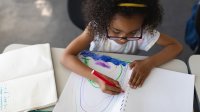Using Art to Help Students Find Their Calm
Simple art activities can help elementary and middle school students express how they’re feeling, which is particularly useful in stressful times.
Your content has been saved!
Go to My Saved Content.As we enter the final months of the 2021–22 school year, we’re all feeling mixed emotions. Our students are experiencing the unpredictability of this time, and with that they’re experiencing many disruptive sensations and feelings. The behavioral challenges teachers have observed this school year are the result of students’ brains and bodies feeling overwhelmed—students are often anxious, worried, or angry.
These challenging behaviors can feel scary or dysregulating to all students who may be observing aggression, defiance, and other responses from peers. Adversity and trauma are personal and live in our nervous systems, manifesting in different ways.
We often try to protect students from these uncomfortable situations by not addressing the underlying conditions, and this can unintentionally create added anxiety, because the unknown is met with a student’s personal interpretation of an outburst or a meltdown from a peer. Our brains predict experiences based on past experiences, and we have a visceral sensory response, which is usually a sensation experienced in our bodies when we’re feeling uncomfortable or we see another person struggling.
If a young person hears someone yelling, a door slamming, a classmate sobbing, or tones of voice that sound harsh, their hearts may begin beating fast, and they can feel tension and tightness in their bodies. These sensory signals occur immediately, before students recognize how they’re feeling. And emotions can be contagious, so other students in the room may begin mirroring or picking up on the dysregulation of classmates and possibly the teacher. But the nervous system is designed to protect us, and our students need to know this.
Students are resilient in their personal responses when adults are authentic and honest, and explain what lies beneath behaviors. Students benefit when we have open conversations with them when the environment is calm and collaborative. And through the expression of art as a daily ritual, we can begin to create predictable and safe practices that can help students access the cortex, where learning occurs.
Much like intentional breathing and rhythmic movement practices, the integration of art activities and practices can create a sense of safety and comfort, reducing stress. Art therapist Linda Chapman finds that “the inherent novelty of creation and self-discovery is life affirming and enlivening.” Below are suggestions for art activities that can calm the nervous system.
When we hold morning or afternoon meetings, we can set these activities up by teaching students about the brain and the nervous system. We can talk about how impossible it is to think clearly or learn when we’re feeling anxious, angry, or sad. We can discuss behaviors as clues or signals about an invisible injury or wound. We can share stories of times when we were feeling lonely, hurt, disconnected, or angry. And we can discuss how our brain is always trying to protect us when we begin to feel rough or dysregulated.
Drawing and creating art are powerful ways to help students express their sensations, feelings, thoughts, strengths, and preferences. Educator Ashlee Harmon and I share art practices we are integrating into our morning meetings and other procedures. Ashlee has created a Mindful Artists Club for her sixth-grade students, and they share and create art with younger students as well.
3 Art Activities to Help Student Express Themselves
1. What Do My Colors Say? Have students fill a sheet of paper with color, lines, and shapes for two minutes. Then ask questions like these: Which color is angry, which shape feels invisible or not seen? Which shape or color is tired or worried? What shapes or lines feel anxious? What name would you give your art? Why? You can ask how their images are like them, and how they are different.
2. Mapping My Favorite Place: Have students draw a map to their favorite real or imagined place, creating roads, paths, mountains, and hills, and showing the route to get there. They can use colors, lines, shapes, and symbols. Ask questions like these: In this place, who are the people you trust? What are the sounds, sights, smells, and colors? What feels calming or exciting about this place? Could you choose to go there in your mind when you’re feeling anxious, upset, worried, or angry?
3. Colors of My Heart: Give each student a blank sheet of paper, and set out markers or colored pencils to share. Students will then draw a large silhouette of a heart, enough to fill their entire paper. After drawing the heart, students can choose three or four colors that represent the emotions and sensations they are experiencing. Using these colors, students will fill in the space of their heart in textures, lines, or patterns of their choice. If students feel comfortable, they may share the colors of their heart with a partner or peer group.
